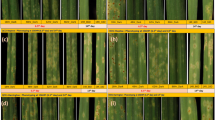Abstract.
Over 90% of the germ tubes of Puccinia graminis tritici (wheat stem rust) and Puccinia hordei (barley brown rust) differentiate appressoria on encountering stomata.There has been controversy as to the role of host topographical signals in the highly precise and efficient induction of these infection structures over stomata by cereal rusts. In the present study, polystyrene replicas of microfabricated silicon wafers, bearing precise microtopographies of defined dimensions, were used to investigate the influence of ridge spacing and height on infection-structure induction by P. graminis tritici and P. hordei. It was found that artificial topographical signals alone can induce a reproducibly high percentage (83–86%) of germ tubes to differentiate infection structures. Multiple, closely spaced (1.5 μm) ridges which were 2.0 μm high provided the most inductive topography. Differentiation on flat surfaces and over single ridges was < 4%. Appressorium induction commonly initiated a cascade of differentiation events involving the formation of infection pegs, vesicles, infection hyphae, and occasionally haustorial mother cells. It is suggested that the close spacing of cell junctions associated with the dumbbell-shaped guard cells of cereal stomatal complexes provide inductive signals for infection-structure formation by cereal rusts in vivo.
Similar content being viewed by others
Author information
Authors and Affiliations
Additional information
Received: 17 October 1996 / Accepted: 5 December 1996
Rights and permissions
About this article
Cite this article
Read, N., Kellock, L., Collins, T. et al. Role of topography sensing for infection-structure differentiation in cereal rust fungi. Planta 202, 163–170 (1997). https://doi.org/10.1007/s004250050115
Issue Date:
DOI: https://doi.org/10.1007/s004250050115




